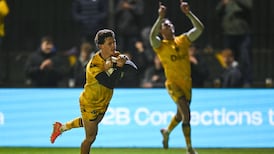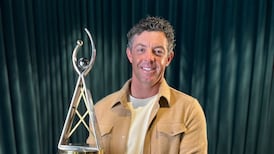One of the biggest sports events of the Irish winter concludes in Clonmel today, though you may not have noticed, or might prefer to look the other way.
More than 25,000 spectators were expected over the three days of the National Coursing meeting, including about 10,000 for today’s finals. For the rest of the year Powerstown Park is a horse racing venue, attracting crowds that don’t come close to those numbers, even on their biggest days.
The event won’t be covered on RTÉ’s sports bulletins, or by many other organs of what is now called legacy media. Picture editors, though, will alight on a shot of a muzzled dog bearing down on a turning hare in full flight, and it might even make the front page of a couple of newspapers tomorrow. The competition for eyeballs is vicious too.
Though you’ve seen variations of that picture a thousand times, it never loses its visceral energy and full-frontal menace. It must be the only sport whose essence can be reduced to an action shot: the dogs, the hare, the chase, all straining and stretching and bulging eyes.
Malachy Clerkin: Rory McIlroy is special because of his vulnerabilities as much as his victories
Matt Williams: As news of the horrors at Bondi broke, I was frantically calling my daughter
Enduring appeal of Katie Taylor built on a combination of class and humility
Tom Hicks met his match when he bought Liverpool
Hare coursing was banned in Northern Ireland 15 years ago, six years after it was outlawed in England and Wales and eight years after Scotland had taken the lead on the matter in these islands.
Ireland, though, is one of only three countries in the EU where hare coursing is still permitted, despite three concerted attempts in the Dáil since 1990 to have it banned.
In Irish society, and in the life of rural Ireland, it has a peculiar existence, at once harassed and protected, mainstream and beyond the pale. In the last budget the Government allocated nearly €20 million to the greyhound industry, of which coursing is an integral part. When justification is sought for State investment on such a scale the first line of defence is that the industry supports 4,000 jobs.
The fascinating thing is how much support coursing has perpetually enjoyed among elected representatives. When the late Tony Gregory raised it in the Dáil 35 years ago it was described, hysterically, as “one of the most emotive issues to come before the house”.
Moving the motion, Gregory invoked Pádraig and Willie Pearse; from the other side of the argument Brian Fitzgerald of Labour returned fire with echoes of Wolfe Tone.
“The coursing fields of Ireland,” he said, “have brought Catholics, Protestants and Dissenter together.”
Gregory’s Bill failed, and another attempt to ban coursing crashed in 2016. Fianna Fáil, Fine Gael, Labour and Sinn Féin all voted against the ban, with just 20 deputies in favour. Think of all the issues of State that have divided the four main parties; on this matter they agreed.
The Sporting Press – the trade paper for the greyhound industry – produced a 40-page magazine previewing the National Coursing meeting last week, emphasising its status as the Cheltenham of coursing.
Michael Lowry – the Don King of Government formation – is pictured on page two, beaming at the ceremonial draw for the weekend’s big stakes.
Lowry has tested the loyalty of his constituents on a range of issues during his political career, but by siding with the hare coursing community he wasn’t going out on a limb. Across the House, it enjoys the support of the political establishment.
Another Bill to ban coursing was brought to the Oireachtas in 2020, sponsored by Paul Murphy, Mick Barry, Richard Boyd Barrett, Gino Kenny, Bríd Smith, Catherine Connolly and Joan Collins, only one of whom had rural constituents. The Bill, though, lacked critical impetus, and it lapsed with the dissolution of the Dáil in November.
Sinn Féin’s argument for not banning hare coursing is that it would be driven underground, and that strict government regulation was preferable. In Britain, there is some evidence to support that position.
In the House of Commons, hare coursing was coupled with fox hunting in a debate that consumed a staggering 600 hours of parliamentary time, more than 20 years ago. Criminalising hare coursing in the UK, though, has not only driven it underground but given it a sinister character.
It only takes a cursory trawl through regional papers in the UK to find a series of serious incidents in recent months. Last week, “a mass convoy of 25 vehicles containing 70 people, linked to hare coursing,” tore through Cambridgeshire farmland, leaving a trail of destruction in their wake.
In Hertfordshire, police released drone footage of men trespassing on farmland for the purpose of coursing, again causing damage. A fortnight ago, a car crashed into a ditch near Peterborough after the occupants were suspected of hare coursing and just after Christmas there was a similar incident in Leicestershire.
Three years ago, the penalties were stiffened to include six months in prison and/or an unlimited fine.
“Hare coursing is a serious problem in some rural areas,” the department for environment, food and rural affairs said in a statement when the new legislation was published.
“Not only does it involve cruelty to wild animals, it is also associated with a range of other criminal activities, including theft, criminal damage, violence and intimidation.”
In Ireland it does not intrude on the day-to-day life of farmers or rural communities. Instead, it is deeply divisive. Anti-blood sport protesters have a range of passionate arguments and never tire of petitioning politicians, but they are still without a significant breakthrough.
When Alan Dukes spoke against Gregory’s Bill 35 years ago, he cautioned the house of falling into the trap of “an anthropomorphic approach,” which he happily explained was “viewing the world of animals through the eyes of human persons”.
A House of Commons report on hare coursing in the early 1990s concluded that if animals of prey were psychologically damaged “by reason of being chased” its capacity to escape would be impaired and the “species would risk elimination by the process of natural selection”. Only one hare in 10 lives long enough in the wild to die of old age, the report continued.
Would any of that change your mind?
Hare coursing is not something about which people are persuaded. There is no middle ground between revulsion and acceptance. In the world of Irish sport, it is hard to think of another subject that has no grey area.
Until you see the picture in the papers tomorrow you might not have thought about coursing for the last 12 months. The image won’t need a caption or an explanation; it will drill straight to your feelings.
















